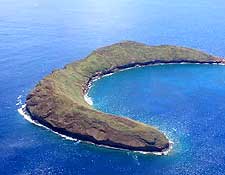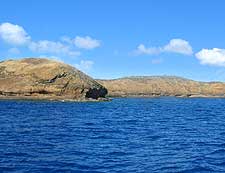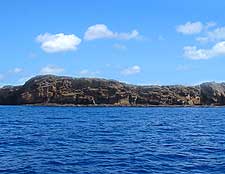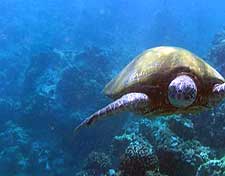Maui Molokini Crater
(Maui, Hawaii - HI, USA)

Located just off the island's southwesterly coast, this famous crescent-shaped volcanic crater is easy to reach from Maui, being situated part-way between the Ahihi Kinau Natural Area Reserve and the neighboring island of Kahoolawe, south of Maalaea Bay.
The sizeable Molokini Crater is partly submerged and measures approximately 0.6 km / 0.4 miles across, being an important Marine Life Conservation District since the 1970s and a seabird sanctuary for frigatebirds, petrels and shearwaters. However, it is perhaps best known for being an easily accessible world-class dive spot.

Molokini actually ranks within the top ten best scuba diving destinations on the planet and has understandably become a major tourist attraction in Hawaii. Located in the region of 2.5 miles / 4 km from the shore of Maui, regular diving and snorkeling tours arrive here most days between April and December, departing from nearby Maalaea Harbor.
Scuba divers will find that the crater's distinctive crescent structure provides much protection from strong waves and as a result, it boasts an incredibly lush and deep coral landscape beneath the surface of the water. Some 250 different fish species now call the Molokini Crater their home, being accompanied by many other inquisitive marine creatures.

Scuba Diving at the Molokini Crater
Those diving here are likely to encounter parrotfish, triggerfish and yellow tangs, as well as occasional white-tip reef sharks, rays, green sea turtles and moray eels. If you are really lucky, you may even be able to swim alongside a passing whale shark. Due to the regular exploration of the reef by divers, the fish can be extremely friendly and quite accepting of visitors.
It is worth noting that early morning generally offers the very best conditions for viewing the reef at the Molokini Crater, and so Maui tourists should be prepared for a check-in at 07:30 and a departure at 08:00, or thereabouts. However, visibility is usually excellent at any time, up to depths of more than 30 meters / 100 feet and more, meaning that those who prefer snorkeling are also in for a treat.

Afternoon snorkeling adventures are also available, suiting Maui tourists who prefer a more leisurely start to the day. Snuba excursions are becoming popular, where an underwater breathing system connects to floating tanks of air via lengthy hoses.
Since landing on the actual crater is strictly prohibited, as is dropping anchors onto the coral, boats use special moorings to secure their vessels. It is also worth noting that you must not touch, feed or disturb any of the creatures, although underwater photography is permitted. Many operators, such as the Pride of Maui catamaran, provide a barbecue lunch onboard before heading back. Most cruises tend to last up to three hours, allowing a good 90 minutes for diving and snorkeling in the water.
Of note, the Fantasy Reef, also referred to as 'Olowalu', provides a popular alternative destination on the rare occasions that visibility at the Molokini Crater is poor.
 Located just off the island's southwesterly coast, this famous crescent-shaped volcanic crater is easy to reach from Maui, being situated part-way between the Ahihi Kinau Natural Area Reserve and the neighboring island of Kahoolawe, south of Maalaea Bay.
Located just off the island's southwesterly coast, this famous crescent-shaped volcanic crater is easy to reach from Maui, being situated part-way between the Ahihi Kinau Natural Area Reserve and the neighboring island of Kahoolawe, south of Maalaea Bay. Molokini actually ranks within the top ten best scuba diving destinations on the planet and has understandably become a major tourist attraction in Hawaii. Located in the region of 2.5 miles / 4 km from the shore of Maui, regular diving and snorkeling tours arrive here most days between April and December, departing from nearby Maalaea Harbor.
Molokini actually ranks within the top ten best scuba diving destinations on the planet and has understandably become a major tourist attraction in Hawaii. Located in the region of 2.5 miles / 4 km from the shore of Maui, regular diving and snorkeling tours arrive here most days between April and December, departing from nearby Maalaea Harbor.
 Afternoon snorkeling adventures are also available, suiting Maui tourists who prefer a more leisurely start to the day. Snuba excursions are becoming popular, where an underwater breathing system connects to floating tanks of air via lengthy hoses.
Afternoon snorkeling adventures are also available, suiting Maui tourists who prefer a more leisurely start to the day. Snuba excursions are becoming popular, where an underwater breathing system connects to floating tanks of air via lengthy hoses.